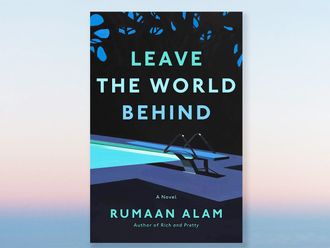Given the complexities of the situation on the ground in Syria, it is a remarkable achievement that the oft-postponed Geneva 2 conference not only convened but continued for the entire scheduled week.
The psychological barrier which prevented representatives of the regime and the Syrian National Coalition (SNC) delegation from meeting face-to-face has been overcome, and this is an important first step.
With a rematch pencilled for next week, an ongoing ‘Geneva process’ may provide a much-needed platform for negotiating an end to the violence which has already cost 200,000 lives and displaced 6.5 million innocent Syrian civilians.
I believe that an unspoken consensus for the short- term has emerged within the international community on the Syrian file, and events at Geneva have endorsed this view. In the long-term, only an agreement brokered and supported by regional powers will produce a lasting solution.
On the last day of the conference, UN special envoy, Lakhdar Brahimi — who had been working to put the talks together since last May — confessed his disappointment that the talks had produced so little agreement. Nevertheless, he spoke optimistically of future meetings.
So what can we glean so far from proceedings in Switzerland?
It is clear that both delegations sought maximum public relations benefit from the situation. Walking away — especially in the early stages — would have lost either side sympathy.
The chance to be in the spotlight in front of the world’s press and 40 highly placed delegates from around the world — including US Secretary of State, John Kerry, UK Foreign Minister, William Hague, and Russian Foreign Minister, Sergei Lavrov — was particularly important for the regime, and part of the ongoing rehabilitation of President Bashar Al Assad, which began with him signing the UN Chemical Weapons Convention in September.
The Syrian regime was not invited to the first Geneva conference in June 2012; simply being present, then, marked a major shift in the way the Al Assad regime is perceived by the international community, tacitly re-instating some of its legitimacy.
Rather than approach the conference as a forum for dialogue, both sides quickly adopted the tactics of Sunday speakers at Hyde Park Corner, taking to the podium as if to a soap-box and advancing their arguments as loudly, dramatically, and for as long, as possible.
Diplomatic red herring
Syrian Foreign Minister, Walid Mua’alem, having been allotted seven minutes for his opening speech, took 40, and became involved in a row with UN Chief Ban Ki-moon who kept asking him to ‘wrap it up’.
By last Monday, the regime delegation had come up with a document setting out its stall, which it called ‘the basic elements for a communique’. This made no mention of the opposition’s key issues, namely ‘transition’ and ‘reform’. Regime spokespeople reiterated they had not come to Geneva for a handover and there was no possibility of Al Assad leaving his post.
Instead, the document began with a diplomatic red herring — that a precondition for peace would be the restoration of ‘occupied territories’ to Syria, meaning the Golan Heights and dragging Palestine and Israel into the fray.
The communique made the far-fetched claim that Syria was already a ‘democracy’ and rejected ‘foreign interference’; this was aimed at the Gulf countries, Saudi Arabia in particular, which have been arming and funding the rebels and which Al Assad derisively refers to as ‘backwards’. It certainly did not mean the Iran-backed military units fighting with the regime including Hezbollah, and Iraqi Shiite militias.
The main thrust of the regime’s diplomatic effort at the conference was the fight against ‘terrorism’ — a theme that plays to the very real anxieties of Syria’s neighbours, the West and the media, and is guaranteed to get their attention.
The opposition, meanwhile, would not budge from its position, based on the 2012 Geneva Conference communique, which demands the formation of a transitional governing body with full powers and implies Al Assad’s removal as a pre-condition.
In the face of this early stalemate, foreign diplomats skillfully guided the talks down another venue — humanitarian aid to Homs. By the end of the conference, however, the regime negotiating team appeared to agree to base the next round on the 2012 document but insisted that nothing else would be discussed before ‘terrorism’ which it has placed firmly at the head of its agenda in Geneva.
Polarised standpoints over the future of Al Assad are at the heart of the international community’s dilemma, which shares the regime’s prioritising of terrorism as the number one concern. Prior to Geneva 2 there were two schools of thought over how to deal with it:
The first, held by the US, Russia and the UK, sees Al Assad remaining in power for a period and cooperating in the elimination of Al Qaida affiliates, Al Nusra and the Islamic State of Iraq and Syria (Isis). The Libyan experience has shown how costly a power vacuum can be, and there is no credible alternative government waiting in the wings in Syria.
Last month, former US Ambassador to Iraq, Ryan Cocker, told the New York Times that ‘the least worse option’ for Syria would be Al Assad’s temporary survival as opposed to Al Qaida establishing deep roots in two contiguous Arab states (Iraq and Syria). In President Barack Obama’s State of the Union address last week, the name of Al Assad was conspicuously absent.
The second view, championed by Saudi Arabia, Qatar and Turkey, seeks the immediate removal of the Al Assad regime, leaving a new transitional government to take up the fight against the Islamists.
At Geneva 2, the former held sway.
Despite Kerry’s assertion that ‘Al Assad cannot be part of a new government in Syria’ (which does not mean that he cannot be part of the present government of Syria), I believe that the West is seeking to expand a ‘moderate’, non-Islamist opposition with the potential to fight in the same trenches as the regime (and possibly ‘moderate Islamists’ such as the Islamic Salvation Front) to oust the jihadists.
Resembling Oslo process
Beyond the overt hatred and hostility displayed by both parties at Geneva 2, the ongoing process may become one of normalisation between the regime and a moderate opposition clustered around the SNC.
Western commentators and diplomats do not fully understand just how personal Arab politics can become. The SNC’s intransigence on Al Assad belies the potential for an accommodation with his regime if he, himself, is removed.
We have only to look at Yemen, where the revolutionary opposition hailed the removal of president Ali Abdullah Saleh to a safe place as a great victory. Never mind that he was replaced by his loyal and long-standing vice-president, Abd Rabbo Mansour Al Hadi.
If Al Assad is effectively sidelined, or — more likely, in my opinion — assassinated, the Syrian political landscape may become less entrenched.
The Geneva process is already beginning to resemble the Oslo process. In order to survive it will need to avoid the most explosive issues, seeking consensus instead on relatively ‘easy’ matters like humanitarian aid and prisoner exchanges. This gives the delegates, and the watching world, the feeling that something, at least, has been achieved. The Syrian official delegation will return to Damascus with glossy carrier bags from Geneva’s fashionable shops, happy in the knowledge that — without having made a single political concession — the international isolation of the Al Assad regime has been broken.
Meanwhile the opposition delegation will return to exile in a variety of hospitable countries, seeking to appease the many opposition factions on the ground in Syria who considered it dishonourable, and a waste of time, to sit with Al Assad’s representatives in Geneva.
The Geneva process has started the ball rolling but, even in the short term, its speed and direction are uncertain. In the long term, a lasting solution to Syria’s woes — and the Middle East’s increasing instability —can only be found regionally.
The elephant in the room is the exclusion of Iran, which was invited to Geneva 2 by Ban Ki-Moon, and then hastily ‘un-invited’ when the SNC threatened to boycott the conference. No lasting peace in Syria can be secured without the endorsement and involvement of the regional superpowers, Iran and Saudi Arabia.
The ongoing hostility between Tehran and Riyadh is at the heart of the region’s problems. It perpetuates the bloodbath in Syria where the two powers are fighting a proxy war — alongside the raging civil war — via a bewildering array of secularist guerrilla armies and militias, from Hezbollah to the Islamic Salvation Front. And it inflames the toxic secular polarisation which threatens the political and social fabric of the Middle East
That America has led the way on rapprochement with Tehran after 30 years’ freeze offers some hope, as does last week’s meeting in Tehran between Turkish Prime Minister Erdogan and President Hassan Rouhani.
We cannot end this article without referring to the people of Syria, whose suffering these diplomatic manoeuverings have done so little to alleviate. As Ahmad Jarba told the assembled delegates in Geneva, ‘Time is like blood for the Syrian people’.
Abdel Bari Atwan is the editor-in-chief of digital newspaper Rai al-Youm: http://www.raialyoum.com










